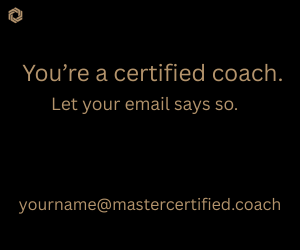Coaching presence is one of the most critical coaching competencies. Being fully present for the client and what arises during the session is key. What comes to mind when you think of coaching presence?
Maybe having a clear mind, being mindful and present in the moment so that you are fully engaged. As any good coach knows, when you are fully present with the client, you can hear both the said and the unsaid.
Sometimes, complete presence with the client is also understood as an experience where the coach’s “self” is removed in the moment, and the coach becomes a conduit for the client to have the conversation with themselves.
However, there is a much deeper level of coaching presence that is possible.
Deeper Coaching Presence
A deeper and more useful coaching presence comes from “being” who the client needs the coach to be in the moment. This is because a coach’s presence is an experience for the client.
Bringing your “being” to the session creates a space for the client where they can rise above their own sense of the world and create new possibilities for themselves. Presence is very closely intertwined with the coach’s being, and it does not have to be the same in two different sessions. Rather the presence of the coach emerges from what the client needs at the moment and the core essence of who the coach is.
It is about shifting from “What is your presence like for the client?” to “What presence would serve the client best at this time?”
Sometimes, that could mean being a calm space and other times, it could mean being a disrupter. A coach’s presence can be challenging or nurturing or be uplifting or reflective.
Ways to Develop a Coaching Presence That Truly Serves Your Client:
- Be fully present: Clear your head, meditate, and breathe. Then, come into the session with an empty head.
- Reflect on what presence would serve the client: Why is the client setting this agenda for the conversation? What do they need from you? What is the underlying need from this session that they are not aware of or able to articulate?
- Be flexible and lean into your intuition: Trust your gut and believe in your wisdom as long as it comes from the intent to serve the client.
- Watch out for the need to please: Avoid the trap of saying the “right” thing. Instead, say what needs to be said. Our clients come to us because we should be able to say things to them no one else will. Be the mirror they need you to be. Be courageous.
- Reflect on whether your presence is serving the client: If not, shift to what would be more useful. After the session, reflect on whether your presence really served the client and if there is something that could have been better or different.
- Work on yourself: If there are things that hold you back from bringing a useful presence (fears, the need to please, etc.), work on them with your coach or therapist.
A deeper presence from the coach allows the client to experience their situation not only as a mirrored reflection but also from the lenses of varied perspectives, hues, distances, and dimensions. It gives rise to a space where the coach and the client are co-creating the journey, not limited by the client or the coach’s views, but one that emerges when the coach can speak to the deeper needs of who the client is.
Disclaimer
The views and opinions expressed in guest posts featured on this blog are those of the author and do not necessarily reflect the opinions and views of the International Coach Federation (ICF). The publication of a guest post on the ICF Blog does not equate to an ICF endorsement or guarantee of the products or services provided by the author.
Additionally, for the purpose of full disclosure and as a disclaimer of liability, this content was possibly generated using the assistance of an AI program. Its contents, either in whole or in part, have been reviewed and revised by a human. Nevertheless, the reader/user is responsible for verifying the information presented and should not rely upon this article or post as providing any specific professional advice or counsel. Its contents are provided “as is,” and ICF makes no representations or warranties as to its accuracy or completeness and to the fullest extent permitted by applicable law specifically disclaims any and all liability for any damages or injuries resulting from use of or reliance thereupon.
Authors
Post Type
Blog
Audience Type
Coach Educators, Experienced Coaches, External Coaches, ICF Chapter Leaders, Internal Coaches, New Coaches, Professional Coaches, Team and Group Coaches
Topic
Coaching Toolbox, Discover - Your Coaching Career
Related Posts
How Conscientious Inclusion Can Improve Your Coaching
Coaching continues to evolve as the world becomes more interconnected, multicultural, and…
The Coaching Trap: When Empathy Becomes Exhaustion
Prepare yourself for the fact that this will not be about you…
Your Guide to Preparing for the ACC Exam
Much like a smartphone upgrade that introduces improvements for a smoother user…








